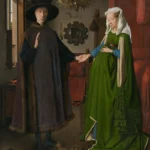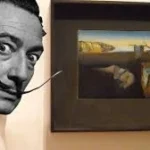
Gustav Klimt’s “The Kiss” is not just a painting; it’s a cultural phenomenon that has captivated art lovers and casual observers alike since its creation in the early 20th century. Renowned for its stunning use of gold leaf, intricate patterns, and evocative portrayal of intimacy, this masterpiece has left an indelible mark on the art world and popular culture. Whether you’re an art enthusiast, a history buff, or simply curious about this iconic work, our exploration of 25 interesting facts about “The Kiss” will deepen your appreciation for Klimt’s genius. From its history and exhibitions to its influence on modern art and its role in popular media, each fact reveals a new layer of significance behind this timeless piece. Join us as we delve into the fascinating world of “The Kiss” and uncover the stories that make it one of the most celebrated artworks of all time.
Artist: “The Kiss” was created by Austrian painter Gustav Klimt, who is one of the most prominent figures in the Vienna Secession movement. Born on July 14, 1862, Klimt’s work is characterized by its decorative style and symbolic content. He was known for his innovative use of materials, particularly gold leaf, which became a hallmark of his later works. Klimt’s artistic journey was influenced by various factors, including his training at the Vienna School of Arts and Crafts, his exposure to different artistic styles, and the socio-political environment of early 20th-century Vienna, which fostered a vibrant cultural scene.
Year: Completed in 1908, “The Kiss” was created during a period of significant change in Europe, both politically and culturally. The early 20th century was marked by a burgeoning interest in modernism, which sought to break away from traditional artistic conventions. Klimt’s work during this time reflects a fascination with the themes of love, sexuality, and the human experience, capturing the zeitgeist of an era that was increasingly exploring the complexities of human relationships. The painting’s completion also coincided with Klimt’s rise to fame, solidifying his status as a leading artist of his time.
Style: “The Kiss” is a quintessential example of the Art Nouveau movement, which emerged in the late 19th century and continued into the early 20th century. This artistic style is characterized by its organic forms, flowing lines, and intricate decorative elements. Art Nouveau sought to unify art and design, emphasizing the beauty of craftsmanship and the integration of art into everyday life. Klimt’s work exemplifies these principles, as he combines fine art with decorative arts, creating a visually stunning piece that transcends traditional boundaries. The painting’s ornate patterns and sensual subject matter reflect the movement’s celebration of beauty and nature.
Dimensions: The painting measures 180 cm × 180 cm (71 in × 71 in), making it a substantial work that commands attention. Its square format contributes to the intimate nature of the composition, drawing the viewer into the embrace of the couple. The size allows Klimt to incorporate intricate details in both the figures and the surrounding patterns, creating a rich visual experience. The scale of “The Kiss” also emphasizes the emotional weight of the scene, as the figures appear larger than life, inviting viewers to engage with the themes of love and connection on a personal level.
Medium: “The Kiss” is an oil painting on canvas, enhanced with gold leaf, which Klimt famously used to create luminous effects and a sense of depth. The application of gold leaf not only adds to the visual richness of the work but also imbues it with a sense of sacredness and timelessness. Klimt’s innovative technique involved layering paint and gold to achieve a textured surface that captures light in unique ways. This method creates a shimmering effect that enhances the romantic atmosphere of the painting, making it an extraordinary example of Klimt’s mastery of materials and his ability to evoke emotion through texture and color.
Location: The painting is housed in the Österreichische Galerie Belvedere in Vienna, Austria, which is renowned for its extensive collection of Austrian art. The Belvedere Museum, located in a historic baroque palace, provides a fitting backdrop for Klimt’s masterpiece, allowing visitors to appreciate the work in a space that reflects its cultural significance. The museum’s collection includes other notable works by Klimt and his contemporaries, making it a vital destination for those interested in the development of modern art in Austria. “The Kiss” is often a highlight of the museum’s exhibitions, drawing art lovers from around the world.
Subjects: The painting depicts a couple embracing, their bodies entwined in a passionate kiss, surrounded by a richly patterned background. The male figure leans in towards the female, who is draped in a flowing gown adorned with floral motifs. This intimate portrayal of love and connection captures the essence of romantic relationships, emphasizing themes of desire and unity. The figures are depicted in a stylized manner, with elongated forms and expressive gestures that convey both tenderness and passion. The contrast between the figures and the intricate background enhances the emotional impact of the scene, inviting viewers to reflect on the nature of love.
Symbolism: The use of gold in “The Kiss” symbolizes divine light and the sacredness of love, elevating the act of kissing to a spiritual level. Gold has historically been associated with wealth, power, and the divine, and Klimt’s incorporation of this material suggests that love is a precious and transcendent experience. The patterns surrounding the couple can also be interpreted as representing the complexities of love and relationships, with their intricate designs reflecting the multifaceted nature of human emotions. This symbolism invites viewers to consider the deeper meanings behind the act of intimacy depicted in the painting, suggesting that love encompasses both beauty and complexity.
Influence: Klimt’s work was significantly influenced by Byzantine art, which is evident in “The Kiss” through the use of gold and ornamental patterns. Byzantine art is characterized by its lavish decoration, religious themes, and the use of mosaics, which Klimt admired and incorporated into his own style. This influence is particularly noticeable in the way Klimt combines flat, decorative elements with the three-dimensional figures, creating a sense of depth and richness. Additionally, Klimt was inspired by the Symbolist movement, which emphasized emotional expression and the exploration of dreams and the subconscious. This blending of influences allowed Klimt to develop a unique artistic voice that resonated deeply with contemporary audiences.
Technique: Klimt’s technique in “The Kiss” features a mix of realistic figures and abstract patterns, showcasing his innovative approach to composition. He skillfully blends representational elements with decorative motifs, creating a harmonious balance between the two. The figures are rendered with a sense of realism, capturing the subtleties of human emotion and interaction, while the background is filled with intricate, abstract designs that draw the viewer’s eye. Klimt’s use of line and color further enhances the painting’s visual impact, with bold outlines defining the figures and vibrant hues adding depth and warmth. This technique not only highlights the intimacy of the embrace but also creates a dreamlike quality that invites viewers into a world of emotion and beauty.
Patterning: The background of “The Kiss” is adorned with intricate, mosaic-like patterns that contribute to the overall visual richness of the work. These patterns are not merely decorative; they serve to create a sense of depth and texture that enhances the emotional impact of the painting. The use of geometric shapes and organic forms in the background contrasts with the figures, drawing attention to the couple while simultaneously enveloping them in a vibrant, almost otherworldly environment. Klimt’s mastery of patterning reflects his interest in the decorative arts and his ability to integrate these elements into fine art, creating a cohesive composition that captivates the viewer’s gaze.
Color Palette: “The Kiss” is dominated by a color palette of gold, yellow, and earth tones, which creates a warm and inviting atmosphere. The extensive use of gold leaf not only adds a luxurious quality to the painting but also symbolizes the divine aspect of love. The warm hues evoke feelings of intimacy and passion, enhancing the emotional resonance of the scene. The contrast between the shimmering gold background and the more subdued colors of the figures emphasizes their forms and expressions, allowing viewers to focus on the tender interaction between the couple. This thoughtful use of color contributes to the painting’s overall sense of harmony and beauty.
Embrace: The couple’s pose in “The Kiss” suggests intimacy and connection, capturing a moment of pure affection and passion. The male figure leans in towards the female, whose head is tilted back in a gesture of surrender and acceptance. This dynamic creates a sense of movement and energy, as if the figures are caught in a moment that transcends time. The embrace is tender yet passionate, reflecting the complexities of romantic relationships. Klimt’s portrayal of this intimate moment invites viewers to reflect on their own experiences of love and connection, making the painting universally relatable despite its specific context.
Feminine Figure: The female figure in “The Kiss” is adorned with a flowing dress that features floral patterns, symbolizing femininity, beauty, and fertility. The intricate design of her gown complements the overall decorative quality of the painting, emphasizing the connection between the figure and the natural world. The floral motifs can also be interpreted as representing love and growth, reinforcing the theme of intimacy. Her long, flowing hair and gentle expression contribute to the portrayal of her as a muse and an embodiment of love. This representation of the feminine ideal reflects the cultural attitudes of the time while also showcasing Klimt’s unique artistic vision.
Male Figure: The male figure in “The Kiss” is depicted in a robe adorned with geometric shapes, contrasting with the organic patterns of the female figure’s dress. This choice of design highlights the differences between the two characters while also suggesting a balance between masculine and feminine qualities. The geometric patterns can symbolize strength and stability, providing a counterpoint to the fluidity of the female figure. His confident posture and gentle touch convey a sense of protection and devotion, enhancing the emotional depth of the scene. This duality in representation underscores the complexity of romantic relationships, where both partners contribute to the dynamic of love.
Artistic Period: “The Kiss” represents Klimt’s “Golden Phase,” a period during which he extensively used gold leaf and explored themes of love, sexuality, and the human experience. This phase marked a turning point in Klimt’s career, as he moved away from earlier influences and developed a distinctive style that combined symbolism with decorative elements. The use of gold not only adds a visual richness to his works but also elevates the subject matter, suggesting that love is a sacred and transcendent experience. This period solidified Klimt’s reputation as a leading artist of his time and had a lasting impact on the trajectory of modern art.
Cultural Impact: “The Kiss” has become an iconic representation of love and intimacy in art, transcending its original context to resonate with audiences worldwide. The painting’s universal themes of affection and connection have made it a popular subject in various forms of media, including literature, film, and advertising. Its imagery is often used to evoke romantic feelings and is frequently reproduced on merchandise, from posters to home decor. The painting’s cultural significance is further enhanced by its association with the Art Nouveau movement, which sought to elevate decorative arts and integrate them into everyday life, thus leaving a lasting legacy in the world of art.
Reproduction: “The Kiss,” created between 1907 and 1908, is one of the most recognized artworks globally, leading to numerous reproductions. This iconic piece has been reproduced in various forms, including prints, digital images, and even textiles. The widespread availability of these reproductions has contributed to its status as a cultural symbol, making it accessible to a broader audience. Many art enthusiasts and casual observers alike have encountered its imagery in galleries, homes, and public spaces, solidifying its place in popular culture.
Exhibitions: Since its completion, “The Kiss” has been showcased in numerous prestigious international art exhibitions. It is a centerpiece of the Belvedere Museum in Vienna, where it has attracted millions of visitors. The painting’s exhibitions often highlight Klimt’s unique style and the Art Nouveau movement, drawing attention from art historians and enthusiasts worldwide. These exhibitions not only celebrate the work itself but also the cultural and historical context of early 20th-century Austria, providing a deeper understanding of Klimt’s artistic vision.
Restoration: The painting underwent significant restoration in the late 20th century to preserve its vibrancy and integrity. Over time, the original oil and gold leaf materials had suffered from environmental factors, leading to fading and deterioration. The restoration process involved careful cleaning and the application of modern conservation techniques to ensure that the artwork remains in optimal condition for future generations. This meticulous attention to preservation has allowed “The Kiss” to maintain its status as a masterpiece while ensuring that viewers can appreciate its full visual impact.
Popularity: “The Kiss” is one of the most popular artworks housed in the Belvedere Museum, drawing an estimated 1.5 million visitors annually. Its popularity can be attributed to its captivating depiction of love and intimacy, combined with Klimt’s distinctive use of gold and intricate patterns. The painting’s allure transcends cultural and geographical boundaries, making it a must-see for art lovers visiting Vienna. Its prominence in the museum has also led to various educational programs and guided tours that explore its themes and techniques.
Merchandising: The image of “The Kiss” has been widely utilized in merchandising, appearing on various products such as posters, calendars, home decor items, and even clothing. This commercialization has helped to further entrench the painting in popular culture, allowing fans of Klimt’s work to incorporate elements of his artistry into their daily lives. The availability of merchandise featuring “The Kiss” demonstrates its lasting appeal and the public’s fascination with its themes of love and beauty, making it a staple in art-inspired consumer goods.
Cinematic References: “The Kiss” has made appearances in numerous films and literary works, often symbolizing romantic love and passion. Its striking imagery and emotional depth resonate with storytellers, leading to its incorporation in various narratives. For instance, the painting has been referenced in films that explore themes of desire and connection, serving as a visual metaphor for the complexities of human relationships. Its presence in popular media not only reinforces its iconic status but also introduces the artwork to new audiences who may not be familiar with Klimt’s work.
Public Perception: The public often interprets “The Kiss” as a celebration of eroticism and sensuality, reflecting the intimate connection between the figures depicted. The painting’s use of gold leaf and intricate patterns creates a dreamlike atmosphere that enhances its emotional resonance. Viewers are drawn to the intimate embrace and the tender kiss, which evoke feelings of love and desire. This interpretation has contributed to the painting’s enduring popularity, as it captures universal themes that resonate across cultures and generations.
Legacy: Klimt’s “The Kiss” has left a profound legacy, influencing countless artists and movements in the art world. Its innovative use of color, texture, and symbolism has inspired modern artists to explore similar themes of love, intimacy, and the human experience. The painting remains a significant part of art history, often studied in academic settings for its artistic techniques and cultural impact. Klimt’s unique style, characterized by decorative elements and a focus on the human form, continues to resonate with contemporary audiences, ensuring that “The Kiss” remains a relevant and celebrated masterpiece.
FAQs about The Kiss (Gustav Klimt’s Painting)
General Questions
- What is The Kiss? The Kiss is a renowned oil painting by the Austrian symbolist artist Gustav Klimt. It is considered one of his most famous works and is a prime example of the Art Nouveau style.
- When was The Kiss painted? The Kiss was painted between 1907 and 1908.
- Where is The Kiss located? The Kiss is currently housed at the Österreichische Galerie Belvedere in Vienna, Austria.
- What is the meaning behind The Kiss? The painting is often interpreted as a symbol of love, passion, and unity. The couple, enveloped in a golden embrace, is depicted in a state of blissful togetherness. The intricate patterns and gold leaf used in the painting add to its mystical and dreamlike quality.
Artistic Style and Technique
- What style is The Kiss? The Kiss is a prime example of the Art Nouveau style, characterized by its flowing lines, organic forms, and decorative motifs. Klimt’s use of gold leaf and intricate patterns adds to the painting’s opulent and sensual atmosphere.
- What techniques did Klimt use to create The Kiss? Klimt employed a variety of techniques, including oil painting and gold leaf application. He used a combination of bold colors and delicate details to create a visually stunning and emotionally charged work of art.
Historical Context
- What was happening in the world when The Kiss was painted? The Kiss was painted during a period of significant cultural and artistic change in Europe. Art Nouveau was emerging as a new style, and artists were experimenting with new techniques and ideas. Klimt’s work reflected these trends, and The Kiss became a symbol of the era.
Visiting The Kiss
- Can I see The Kiss in person? Yes, you can see The Kiss at the Österreichische Galerie Belvedere in Vienna, Austria.
- What are the best times to visit the Belvedere to see The Kiss? It’s recommended to visit the Belvedere during off-peak hours to avoid crowds. Additionally, checking the museum’s website for any special exhibitions or events can help you plan your visit.









